SOLD
1940-1950 Vintage Linen/Cotton Twill Fabric Made Livestock Dealers “Gris de Travil” Work Coat by French Old Manufacture “Au Molinel”
もともとは働く人たちにとっての上っ張りとして、 汚れの防止や機能性だけを考えて作られたはずのワークコート。
しかしフランスで作られた物は、 実用一点張りで無骨な物が大半の英国やアメリカの物とは 趣の異なる素材感やシルエットと 機能性を重視しながらも、そこかしこに散りばめられた フランスの粋と機能的装飾デザインの素晴らしさから 現代にも通用する別格のものを確立させています。
Work coats were originally designed to be used as a top for working people, to prevent stains, and to be functional.
However, those made in France have established something exceptional that can be used in the modern age from the splendor of French style and functional decorative design scattered here and there, while emphasizing functionality and a different sense of material and silhouette from those in England and America, where most of the items are practical and rugged.
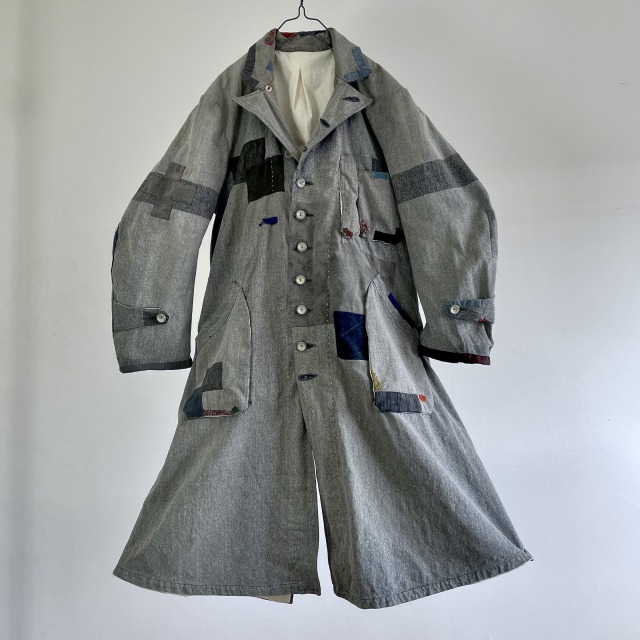
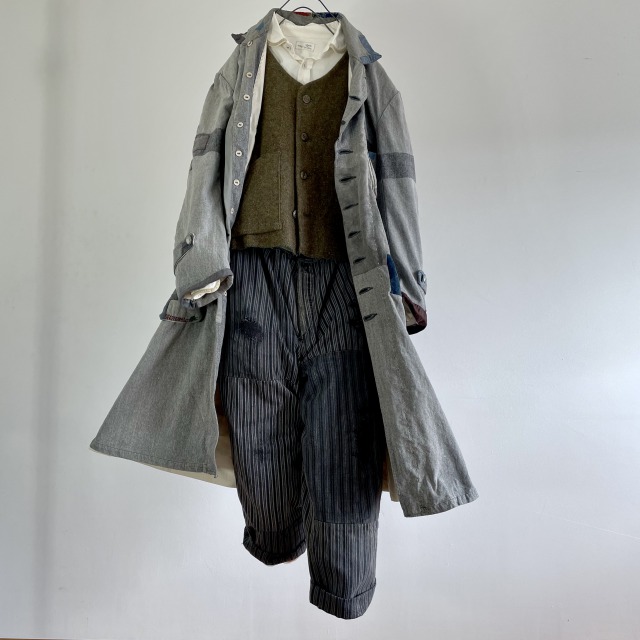
緯糸がブラックで経糸が白と黒のメランジ糸で織られ、白色と黒色が入り混じった色合いの生地からフランスで、“GRIS de Travail” (グレーの仕事着)と呼ばれるワークウエア。
This workwear is called “GRIS de Travail” (gray workwear) in France because of its mixed color of white and black, woven with black weft yarn and black and white warp yarn melange.
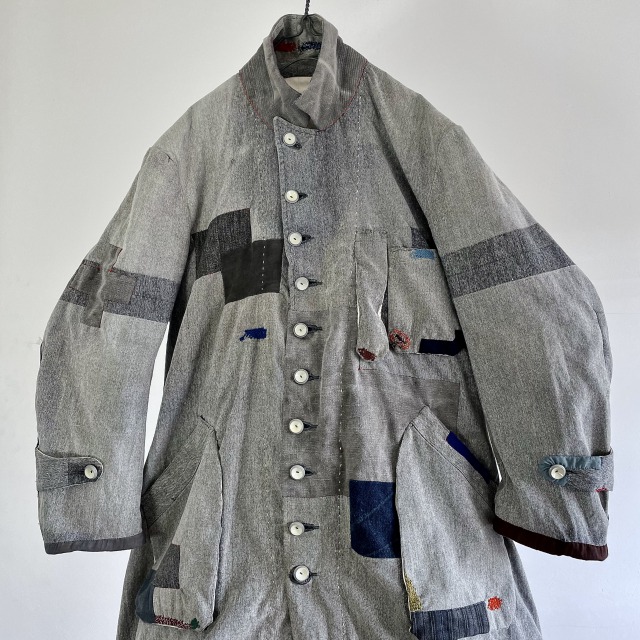
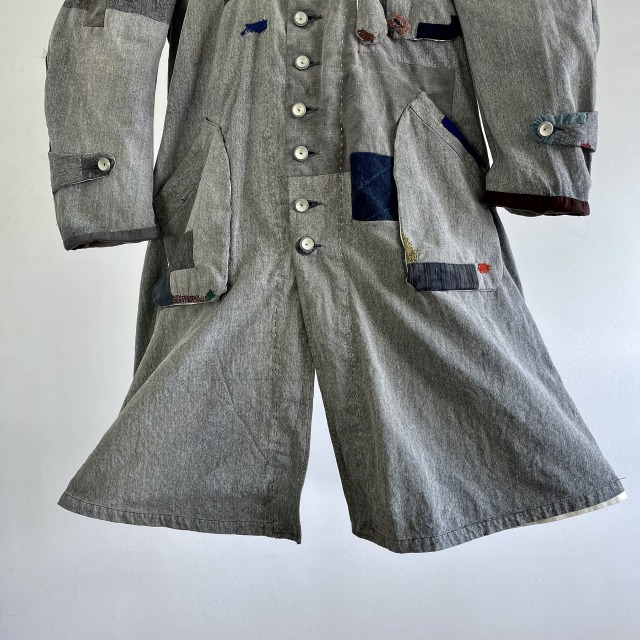
1940年代に作られたこのコートも大きなポケットや、ゆったりした分量など、作業時のオーバーコートとしての機能を果たしながらも曲線を多用したポケットの装飾的なデザインや、立体的な造形など単なる労働着を超えた意匠に満ちています。
This coat, made in the 1940s, also has large pockets and a loose fit, fulfilling the function of an overcoat for work, but it is also filled with designs that go beyond mere work clothes, such as the decorative design of the pockets with many curves and the three-dimensional modeling.
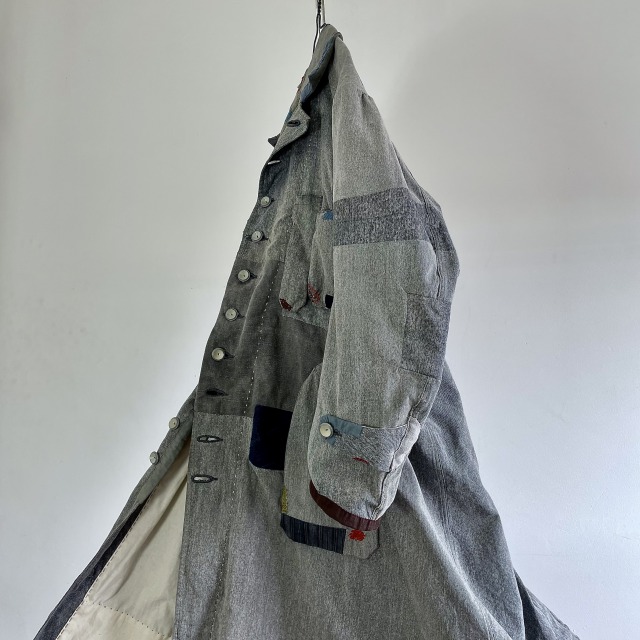
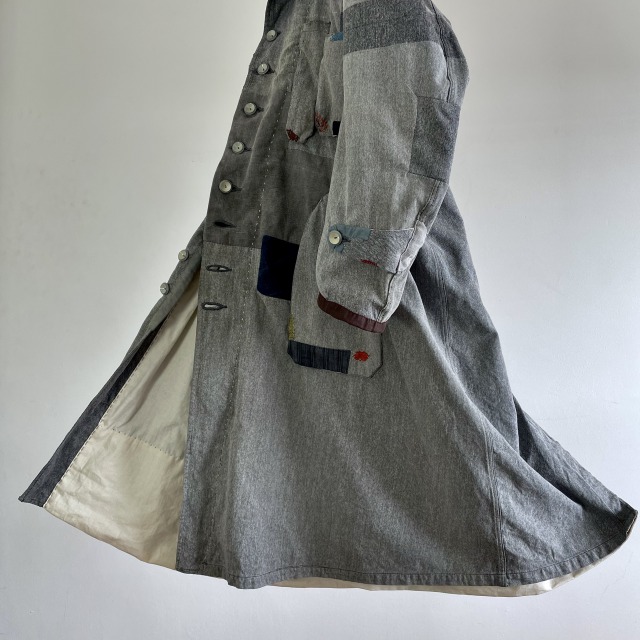
1940年代、占領とその後のフランス。戦勝国となったとはいえ、戦火に晒され、経済的に疲弊しきっていたフランスの復興を支えた労働者たちの仕事着です。着込まれて薄いグレーに進化し、経てきた時間を映す水墨画のような陰影とふくよかな皺は、決して加工では再現できない創造性を持っています。
France in the 1940s, during and after the occupation. These are the work clothes of the workers who supported the reconstruction of France, which was exposed to the fires of war and was economically exhausted even though it became a victorious country. The shadows and wrinkles that reflect the passage of time, like ink drawings, evolve into a light gray as they are worn, and have a creativity that can never be reproduced by processing.
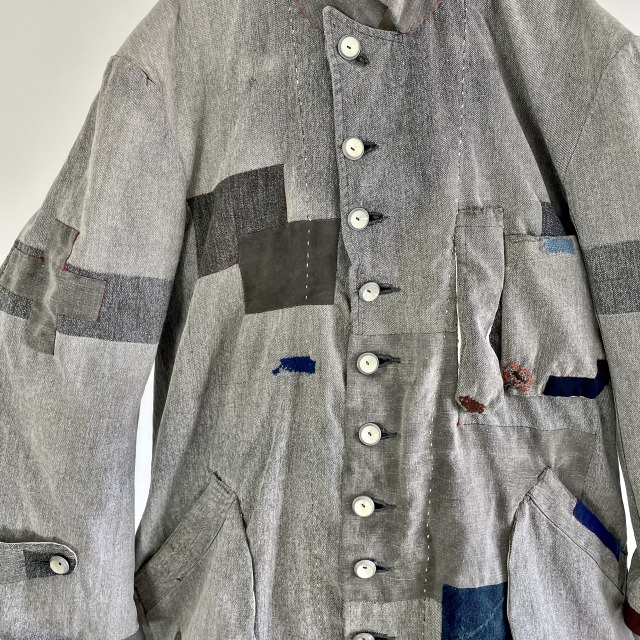
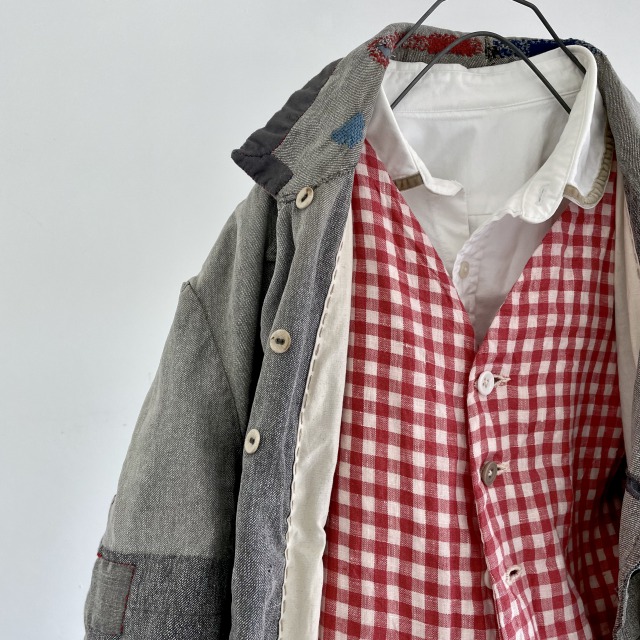
フランスのワークウェアでリネンを使った生地の代表格の“Au-Molinel”のLinen/Cottonのツイル生地。経糸にチャコールグレーとブラックのメランジ糸、緯糸にオフホワイトの糸を使って織り上げたツイルで、より深い色合いと生地の厚みを作り出しています。
This is a linen/cotton twill fabric from Au-Molinel, one of the leading linen fabrics used in French workwear. This twill is woven with charcoal gray and black mélange yarns in the warp and off-white yarns in the weft to create a deeper color and thickness.
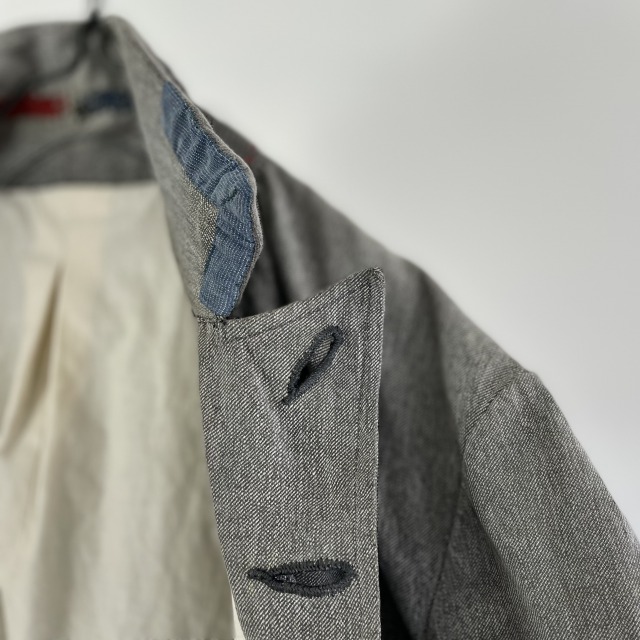
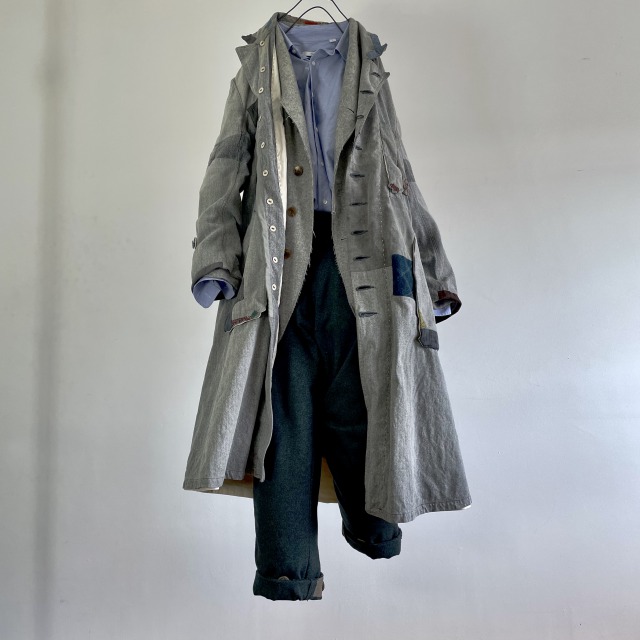
Molinel社はフランス北東部のLilleで1845に創業され長い歴史を誇る会社で、一貫して労働着を作り続けて現代に至ります。ベルギーとの国境に近く、交易の盛んな街として発展したLilleは、19世紀頃から繊維工業を中心とした工業都市として発展し、Molinel社もその中の一社で、{Au MOLINEL}のブランドはLilleの旧市街の目貫通りの“Rue de Molinel”に由来します。
Molinel was founded in 1845 in Lille, in the northeastern part of France, and has a long history of making work clothes. Lille, which is close to the border with Belgium and developed as a prosperous trading city, developed into an industrial city centering on the textile industry from the 19th century, and Molinel is one of those companies. The brand name {Au Molinel} is derived from the “Rue de Molinel” on the main street in the old town of Lille.
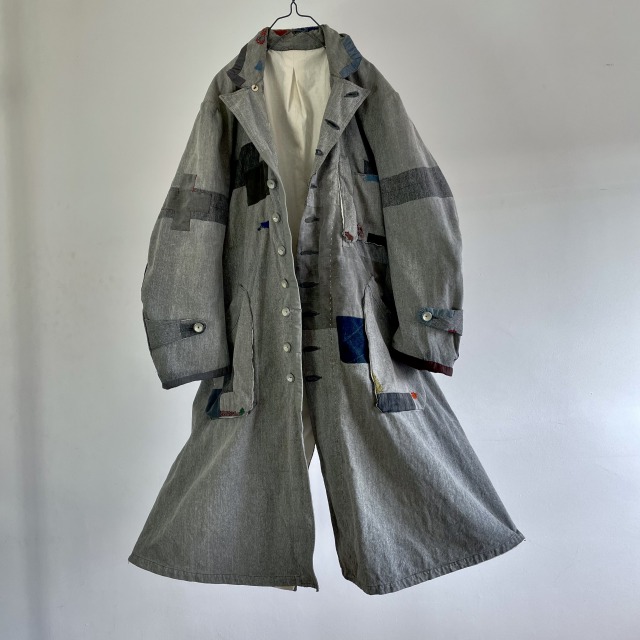
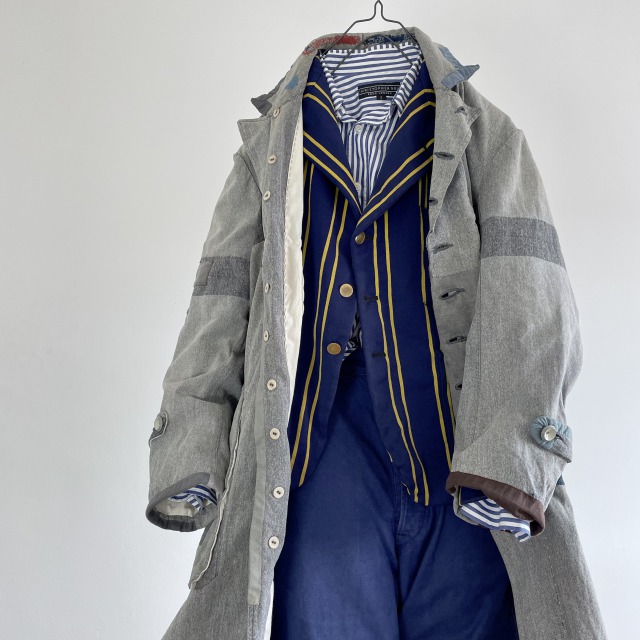
Lilleは繊維産業以外にも石炭も産出し、石炭業や石炭を使用する鉄鋼業も盛んな労働者の都市であり、Molinel社が労働着の専門会社の道を歩んだのは素晴らしい着眼点でした。また、Lilleはベルギーからフランスに広がる世界一のリネンの耕作地であるコルトレイク地方に隣接する地域で、リネンはLilleの繊維産業の中心素材でもあります。
Molinelが他社があまり扱えないLinenを使った労働着を得意としたのは、このような有利な条件に恵まれていたと考えられます。
In addition to the textile industry, Lille is also a coal-producing, worker’s city with a thriving coal industry and a steel industry that uses coal, so Molinel’s decision to go the way of a company specializing in workwear was a great one. Lille is also adjacent to the Kortrijk region, the world’s largest linen-growing area that stretches from Belgium to France, and linen is a core material in Lille’s textile industry.
It is thought that Molinel was blessed with such advantageous conditions that it was able to specialize in working clothes made of linen, which few other companies could handle.
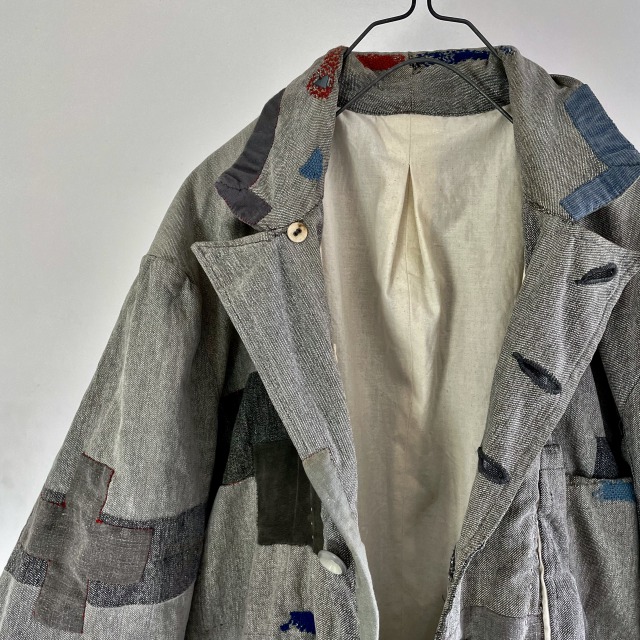
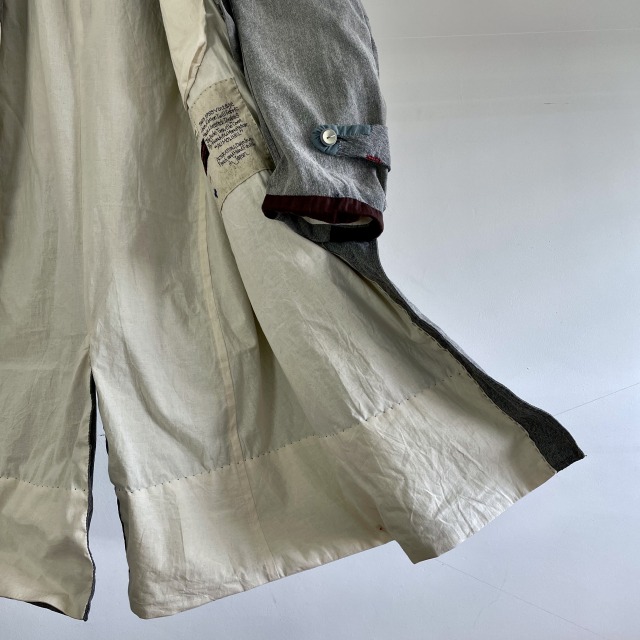
この1枚は様々な労働着を製造していたMolinel社の中で、家畜商向けに作られたもの。胸にパッチポケットの他にブラシや鋏用のポケットが取り付けられているのが特徴です。
This piece was made for livestock dealers by Molinel, a company that manufactured a variety of work clothes. It features a patch pocket on the chest as well as pockets for brushes and shears.
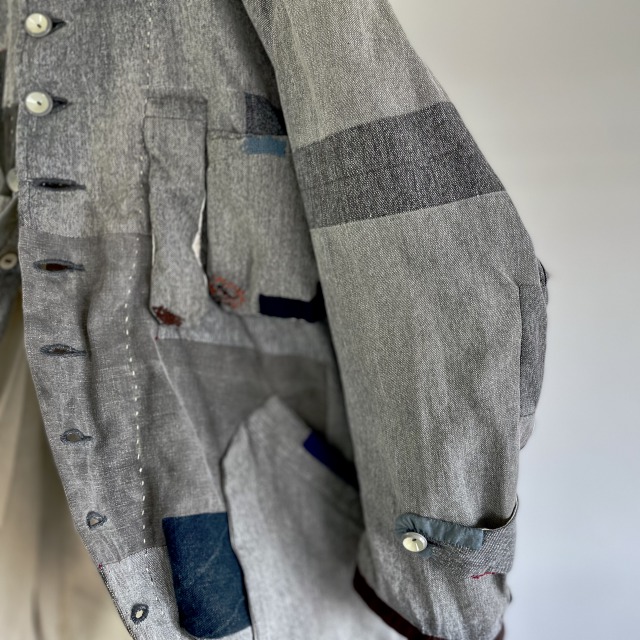
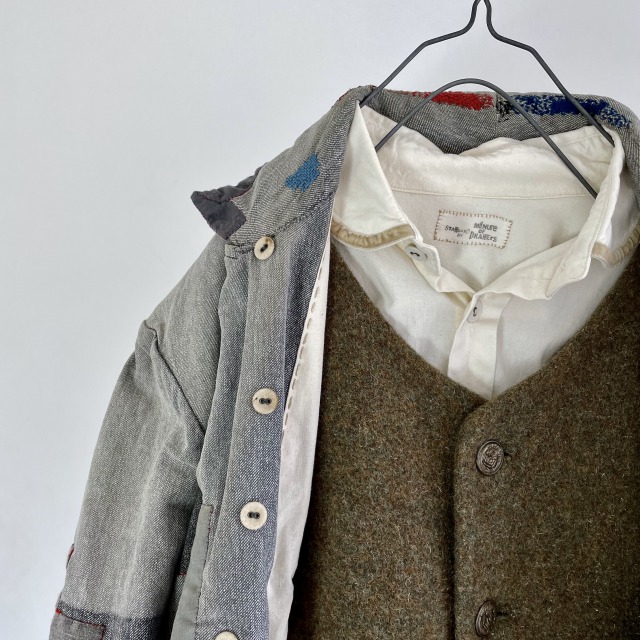
家畜商の上っ張りとして、インディゴ染のリネンを使ったBiaudeやMaquignonのコート、パリの食肉家畜市場のla villetteがそのまま俗称として生地名と衣類名にもなったVilletteなどとともに用いられていたグレーの仕事着です。
These gray work clothes were used by livestock traders as their top coat, along with Biaude and Maquignon coats made of indigo-dyed linen, and Villette, which was the common name for the fabric and clothing of the Parisian meat and livestock market, la villette.
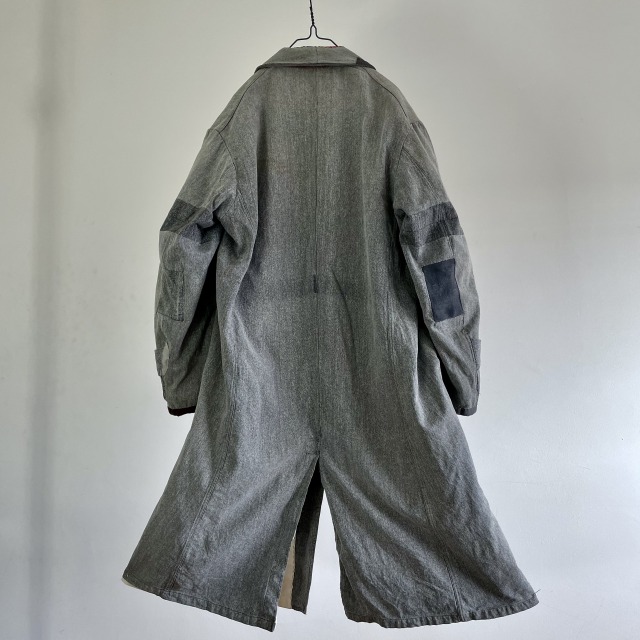
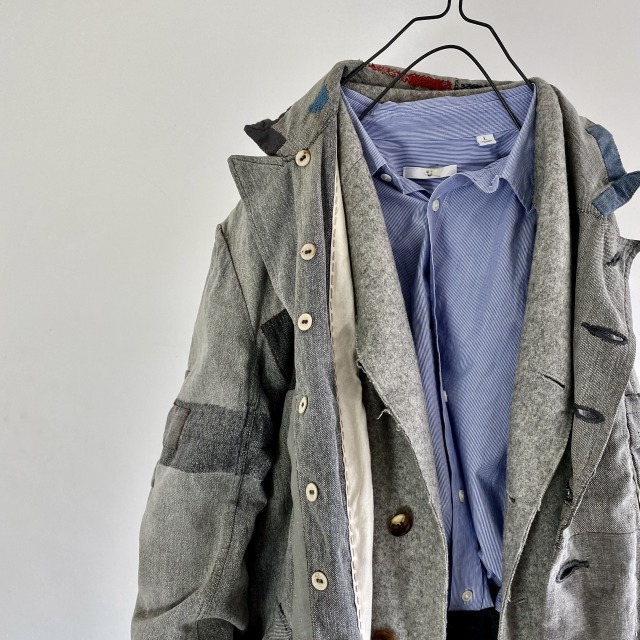
ワークコートは働く人たちにとっての上っ張りとして、 汚れの防止や機能性の求めに応じて作られました。
その証拠に米国や英国のものは、頑丈な素材を使い2重3重のステッチが入った直線的なディティールで、縫製効率や生地要尺の節減、意匠よりも機能優先の基本にしたがった頑丈で無骨な物が殆どです。
Work coats were made to serve as a top for working people, to protect them from dirt and to meet their functional needs.
Evidence of this is that most American and British coats are made of sturdy materials and have linear detailing with double and triple stitching, and are sturdy and rugged according to the basic principle of prioritizing function over sewing efficiency, fabric saving, and design.
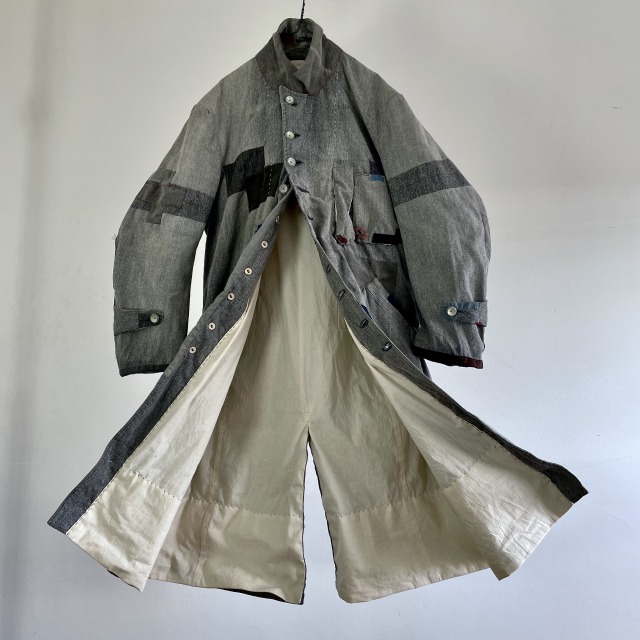
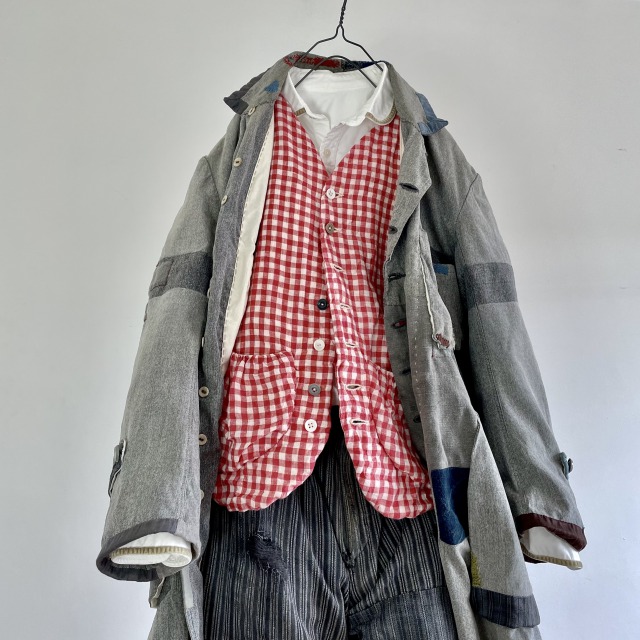
直線に比べて縫製に時間と技術が必要な上に、生地の用尺も増えて非効率な角をとったりカーブを描いたりしたポケット。ポケット口の見返しにも意匠が施されていたり、もともと手の込んだ仕様の手間と時間をかけられたポケット。一度解体し、ダメージを古いリネン生地などで補修した後に、裏に生地を縫い合わせ、それをもう一度手で内縫いすることで縁を浮かせて立体的に再表現。ぷっくりとしたフォルムと、縁から覗く裏地の生成りが軽さと動きを与えます。
Compared to straight lines, pockets with curved or angled edges require more time and skill to sew, as well as more fabric to use, making them inefficient. Pockets with elaborate and time-consuming designs, such as those on the back of the pocket opening. After dismantling and repairing the damage with old linen fabric, the fabric is sewn together on the reverse side, and then sewn inside by hand again to make the edges float and re-express the three-dimensional shape. The plump form and the raw color of the lining peeking out from the edges give it lightness and movement.
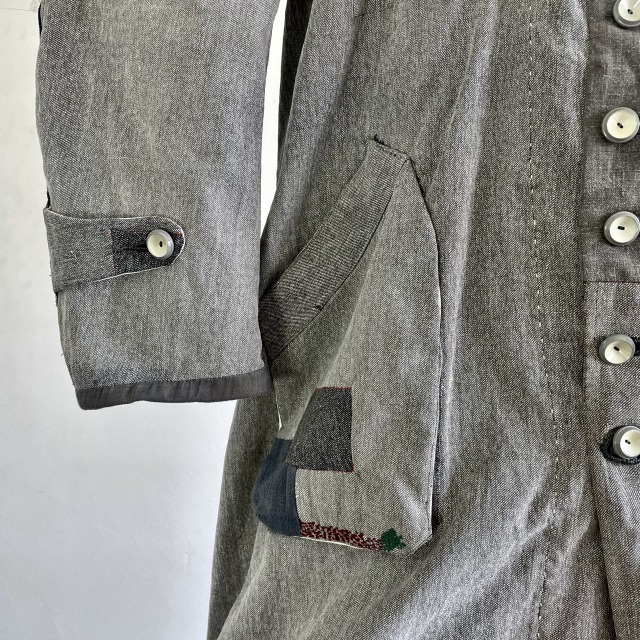
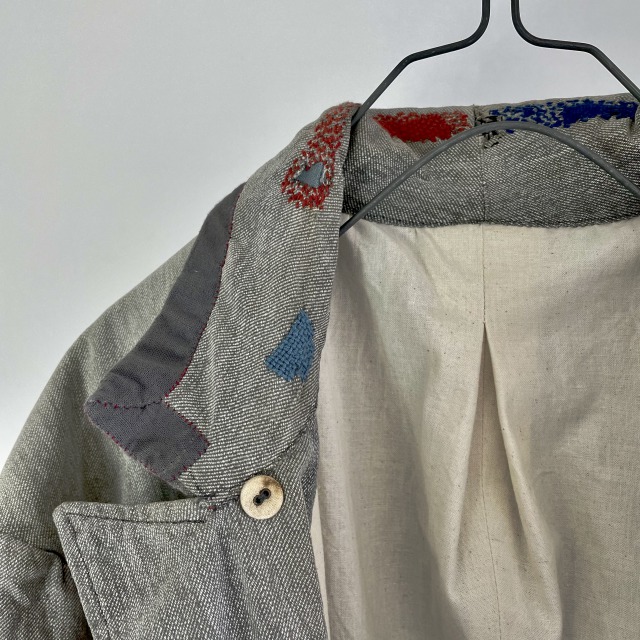
縫い付けられていた小さなラベルには、白地に赤い字で元の持ち主のイニシャルと思われるものが記されていました。持ち主にとって大切な服だということをしめす印です。
The small label that had been sewn on had what appeared to be the original owner’s initials in red letters on a white background.It is a sign that the clothes are important to the owner.
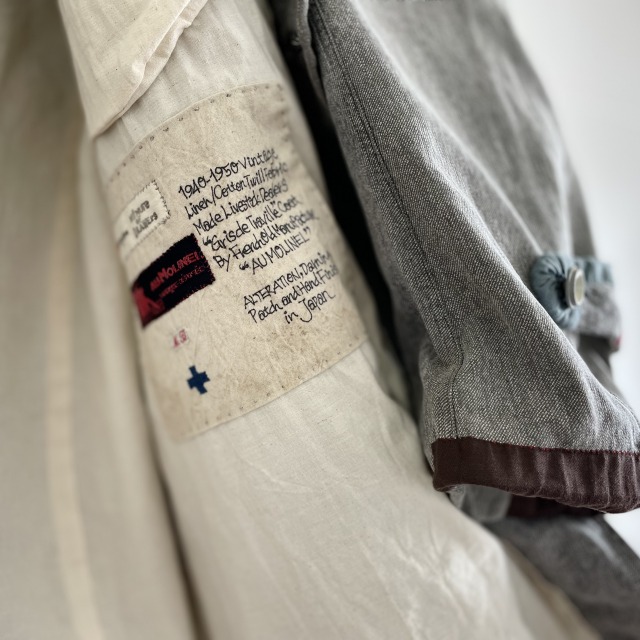
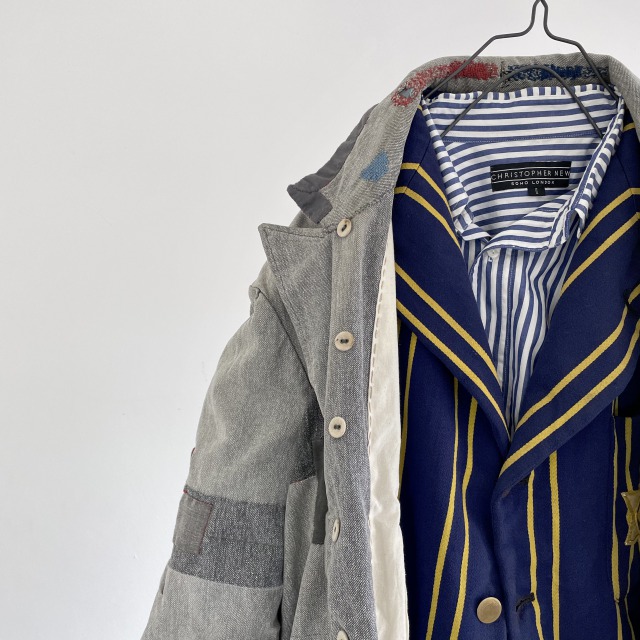
経てきた長い時間を取り込んだ風合いと、着込まれた涸れた色合いが深みを加え、愛用のしるしのダメージが辿ってきた時間を色濃く映し出しています。前身頃の大きなダメージにはインディアインク染めの古いリネンをあてました。
The texture of the garment has taken in a long time, and the dry color of the garment adds depth, and the damage that shows the signs of love reflects the time that has passed. The large damage on the front is covered with old linen dyed with India ink.
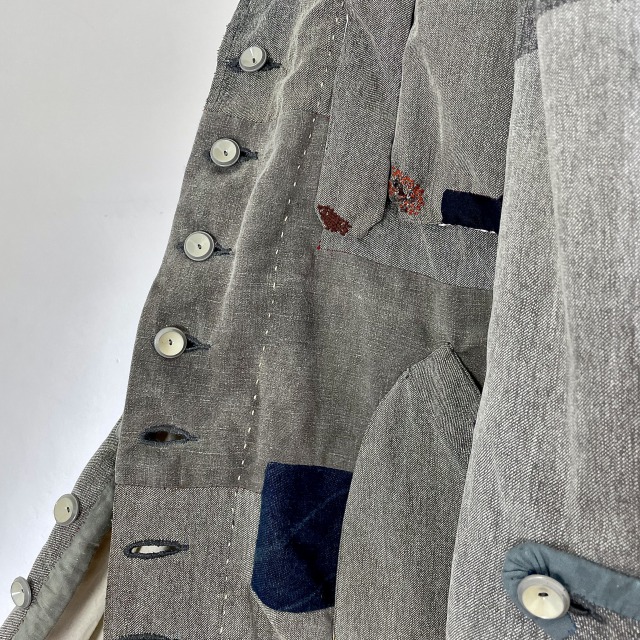
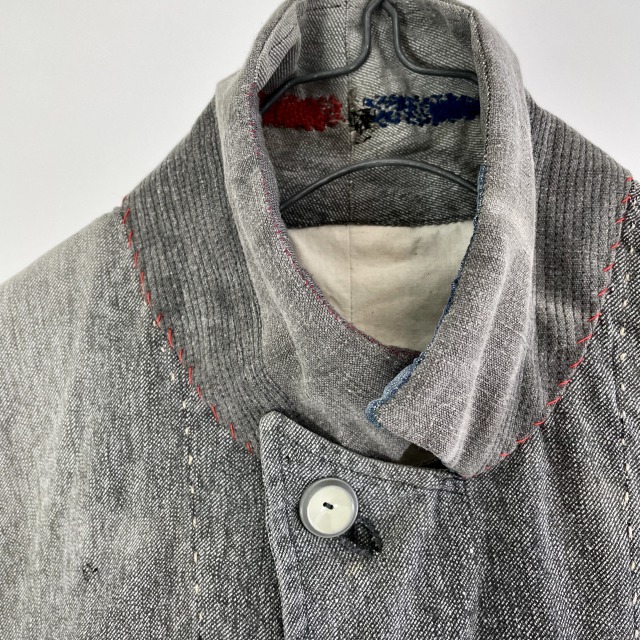
インディアインク染のリネンで作り変えた裏襟。ステッチと身頃へ止め付けるハンドステッチのグレーとのコントラスト。
Back collar made of India ink-dyed linen. The contrast between the stitching and the gray of the hand stitching on the body.

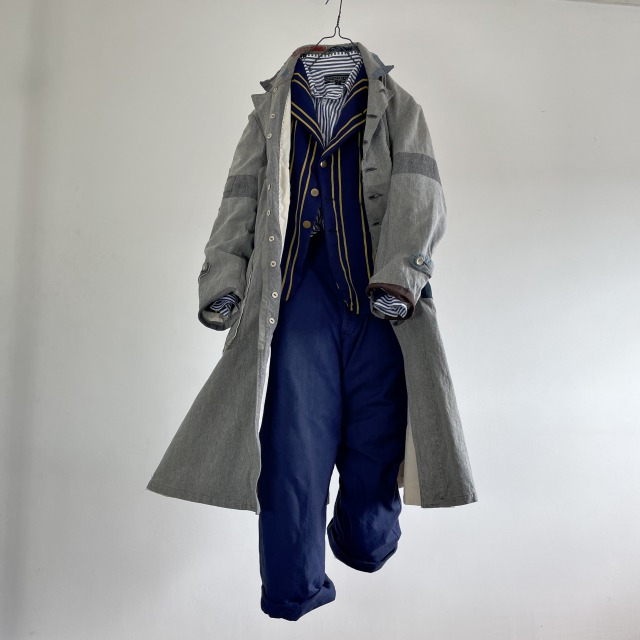
ボタンはフレンチヴィンテージのデッドストックのボタンです。グレーの2トーンの組み合わせと凝った形が、味わいを加え、ともすれば強くなりすぎるアンティークの重さを中和してくれます。
The buttons are French vintage deadstock buttons. The combination of two tones of gray and the elaborate shape add flavor and neutralize the weight of antiques that can be too strong.
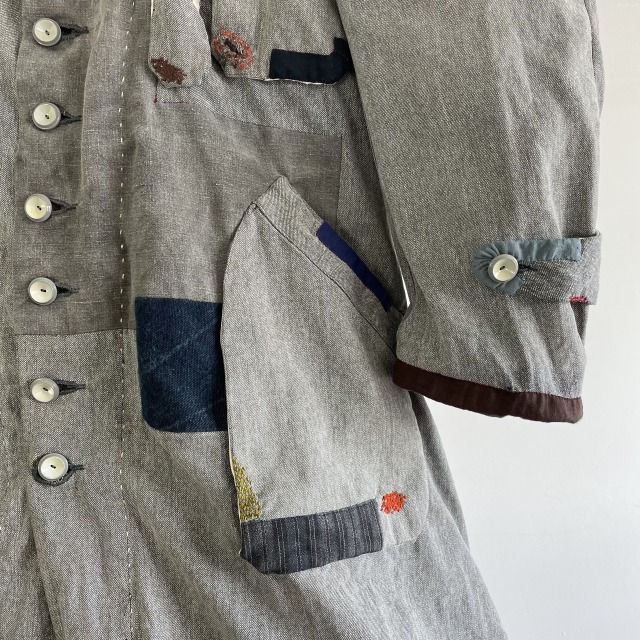
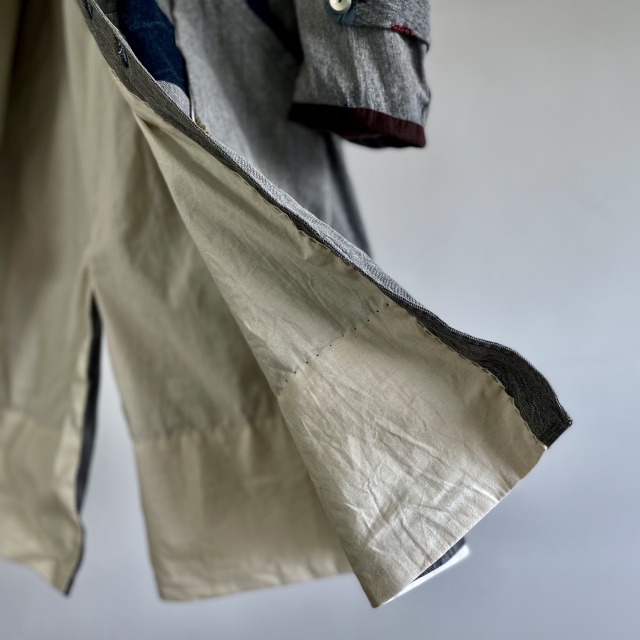
ボタンの間隔を狭め、数を2倍に増やしています。ボタンホールはリネンコードの手かがりです。
The spacing between the buttons is narrowed and the number of buttons is doubled. Buttonholes are hand-tied with linen cord.
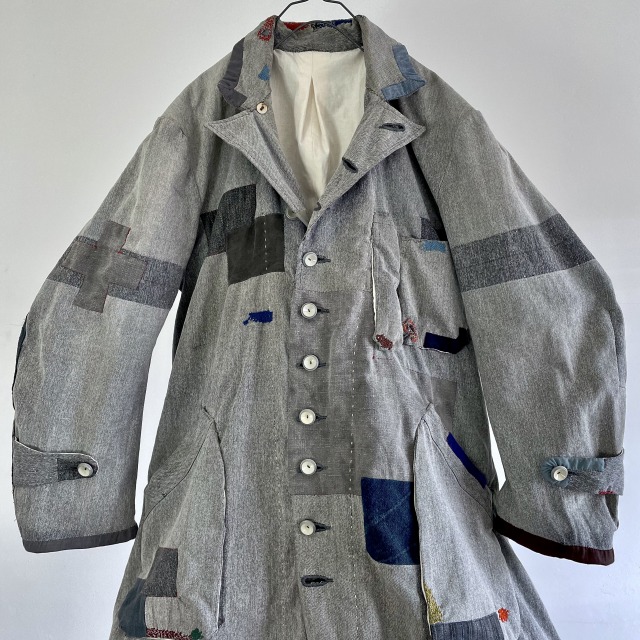
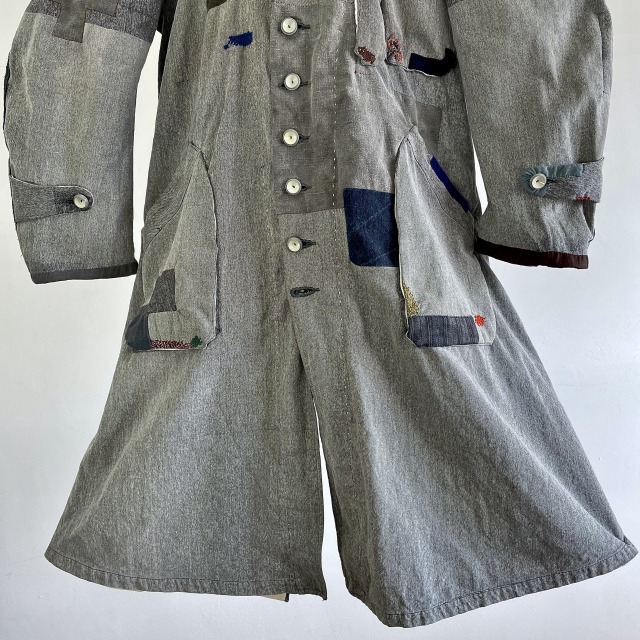
縁を浮かせて手で内縫いした丸みのある立体的なライナーサイドのポケット。
Rounded, three-dimensional liner side pockets with floating edges and hand-stitched inside.
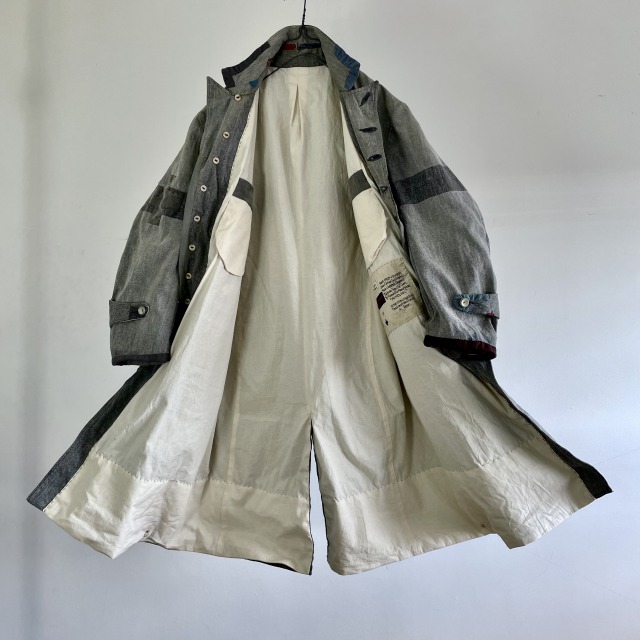
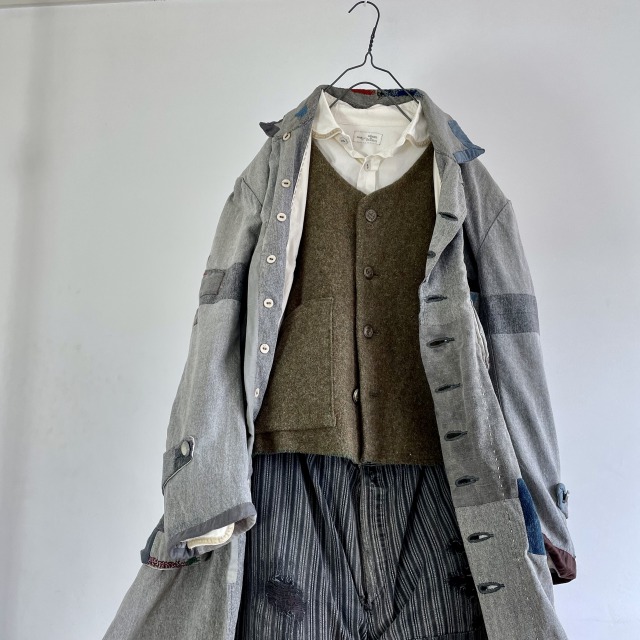
元のオーナーが長すぎた袖をたくしあげて縫い留めた跡が描く模様。
The pattern is made by the original owner’s sewing up the sleeves that were too long.
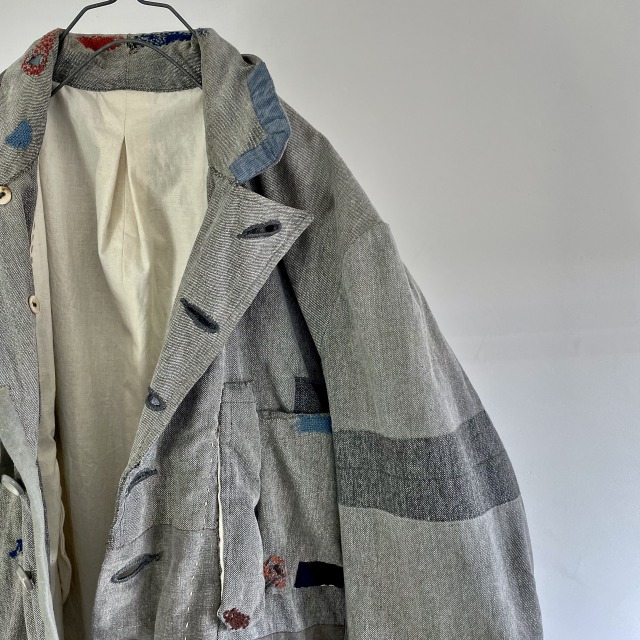
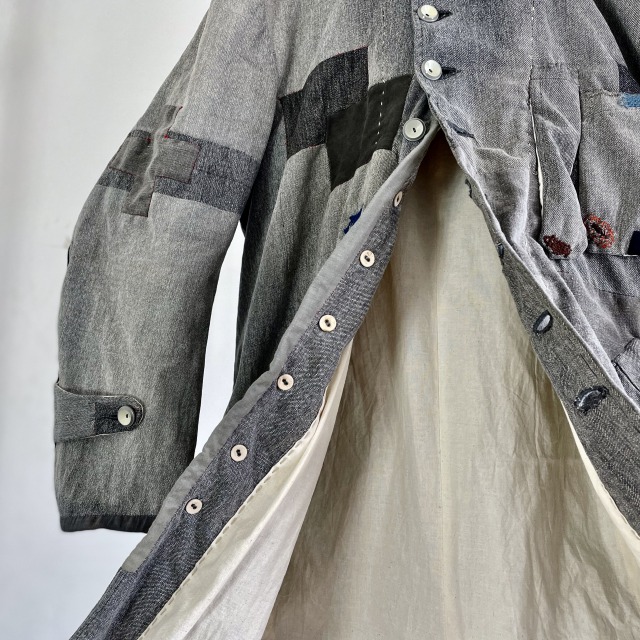
クロス型のpatchを腕に。
Cross-type patch.
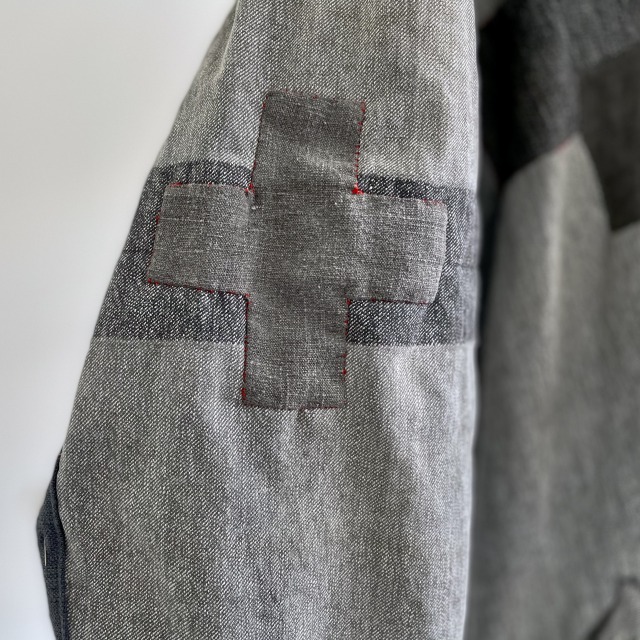
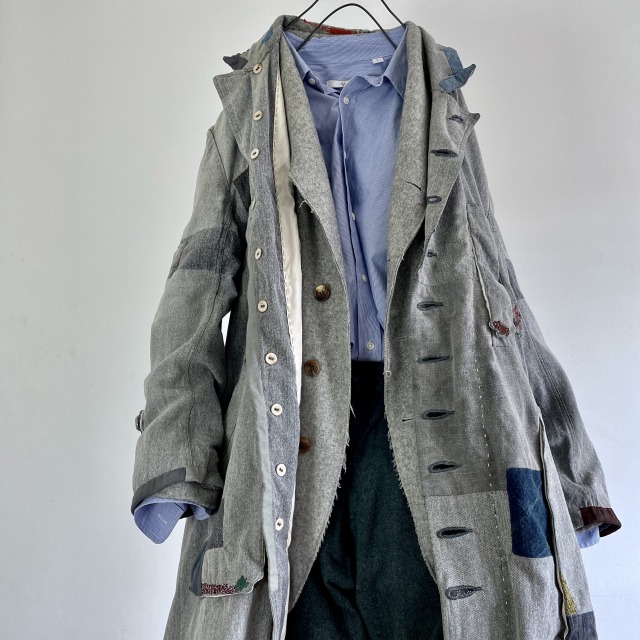
「汚れが目立たない」という理由だけで採用されたのだとは信じられないほど完成された色合いと風合い。
“The color and texture are so perfect that it’s hard to believe that it was adopted just because it doesn’t show dirt.
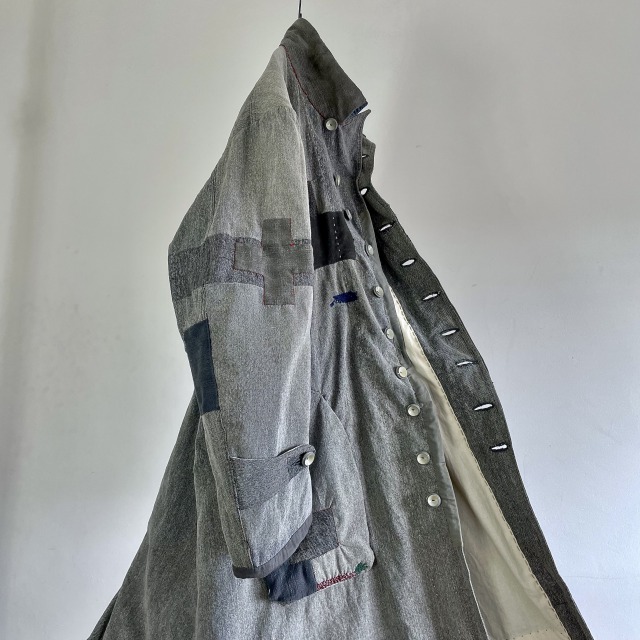
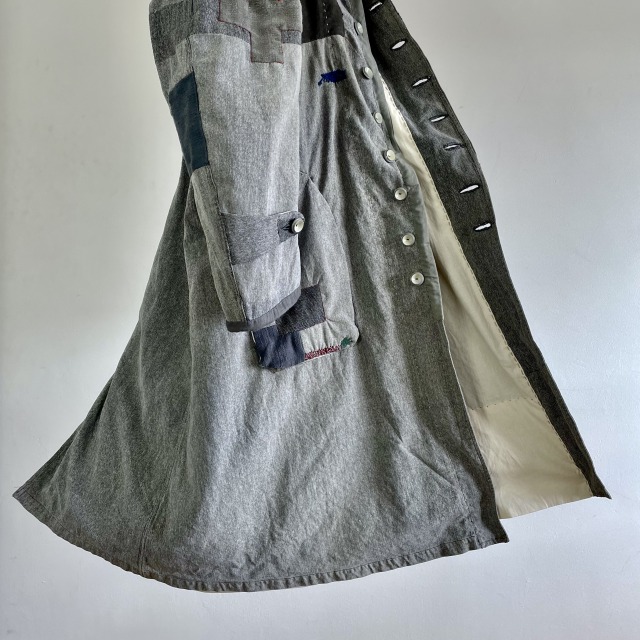
着込んでいくことで進化した時間を映す水墨画のような陰影をは、これからもますます深い姿となる日が楽しみを秘めています。
I look forward to the day when the shade like ink painting reflecting the time evolved by wearing it will become deeper and deeper in the future.
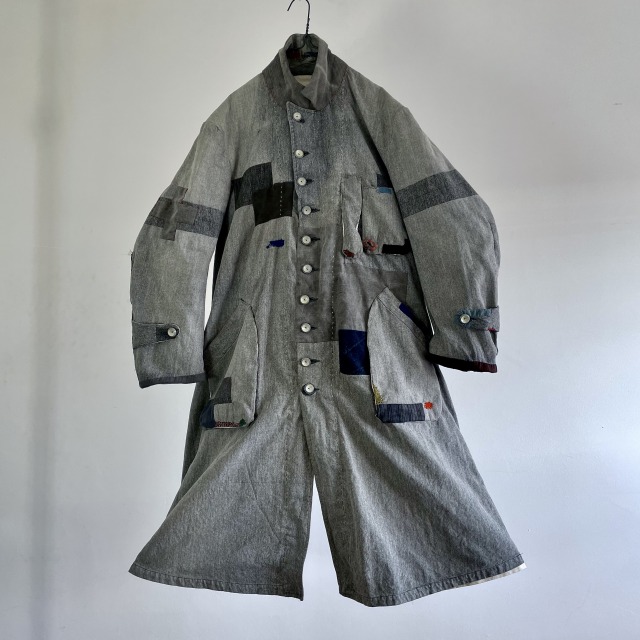
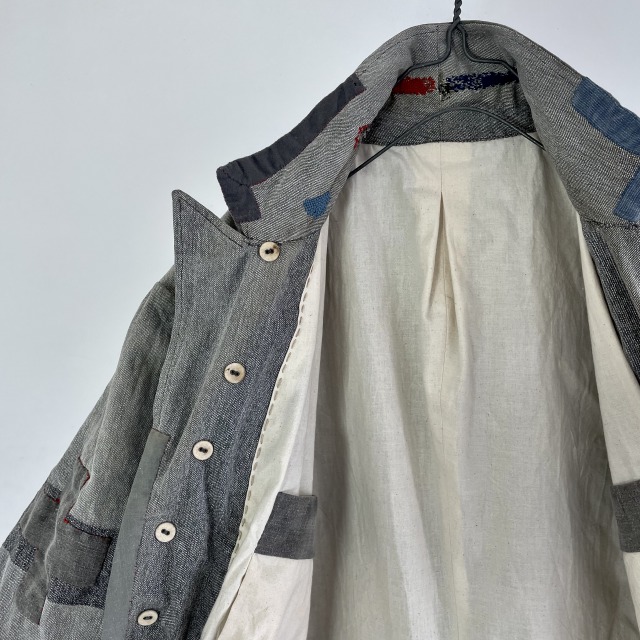
腕の稼働の必要性に合わせて幅を広げつつ曲線を描きだす美しい袖の作り。
テーラーワークを基本としたパターンメイクと縫製が、「 ファッション 」 と対極の位置にあるはずの「仕事着」を、様々なメゾンやデザイナーがモデルとする高みに今も位置付けます。
The beautiful sleeves are made to curve while widening according to the necessity of arm movement.
Patternmaking and sewing based on tailor’s work positions “work clothes”, which should be the opposite of “fashion”, at the height that various maisons and designers use as a model.
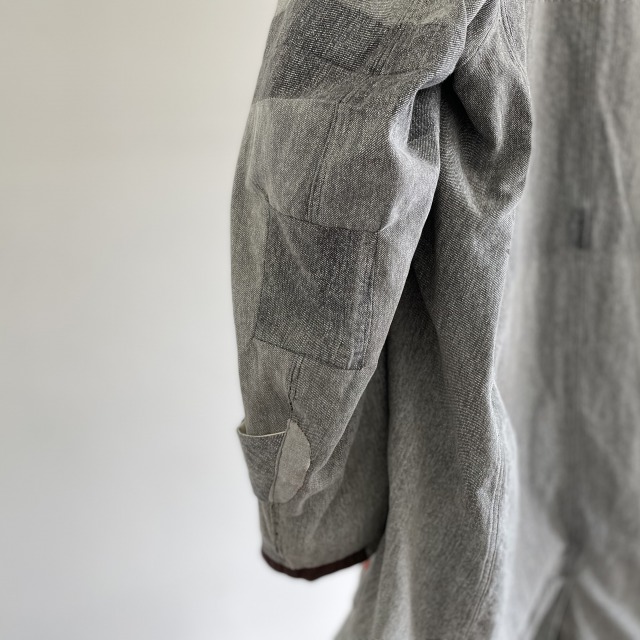
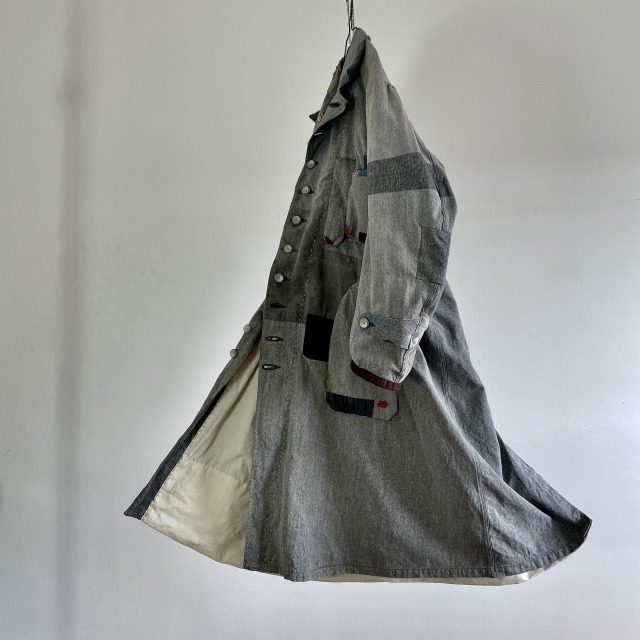
手の温もりではなくストイックさを伝える不揃いなステッチ、縫い皺の表情や生地のコントラストが乾いた奥行きを作りだします。
The uneven stitching that conveys stoicism rather than hand warmth, the expression of stitch wrinkles and the contrast of fabrics create a dry depth.
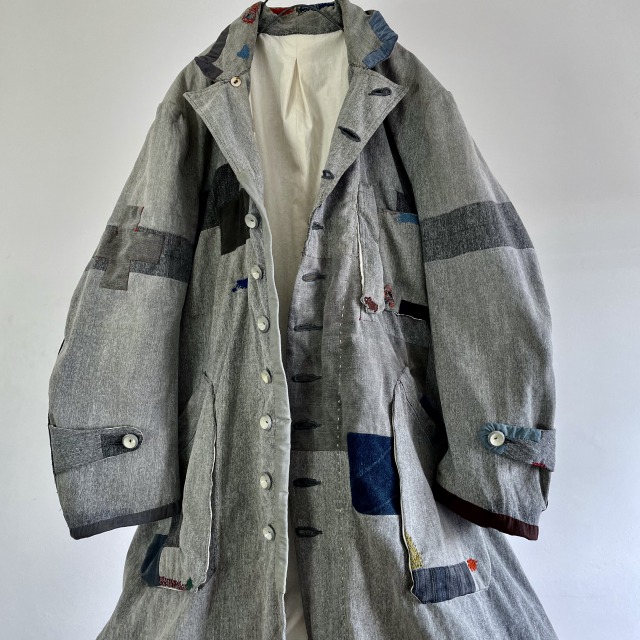
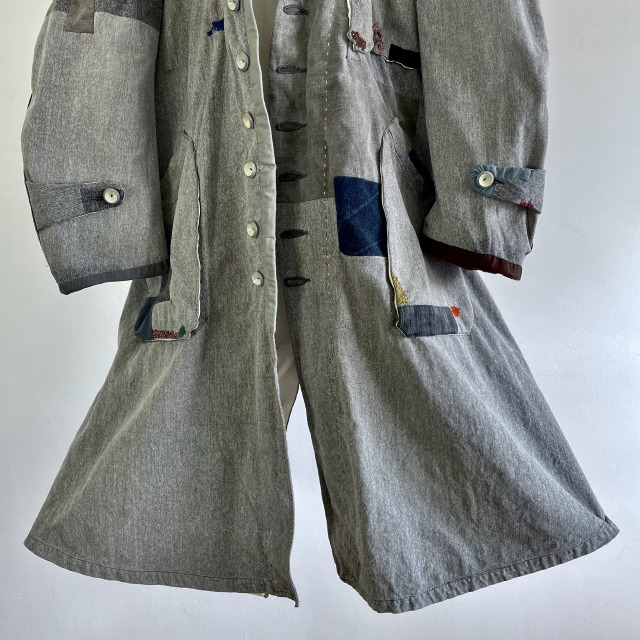
ファッションとは無縁のはずの世界である仕事着に込められた、フランスのセンスが、多くの愛好家を生み、惹きつけ続け、お手本となり続ける、フランスというモード発祥の地が培った“ ファッションの原点 ” が生み出したワークウェアの到達点の一つです。
The French esprit and sense put into workwear, which is a world that should have nothing to do with fashion, has given birth to many lovers and continues to attract them, and continues to be a role model. It is one of the achievements of workwear.
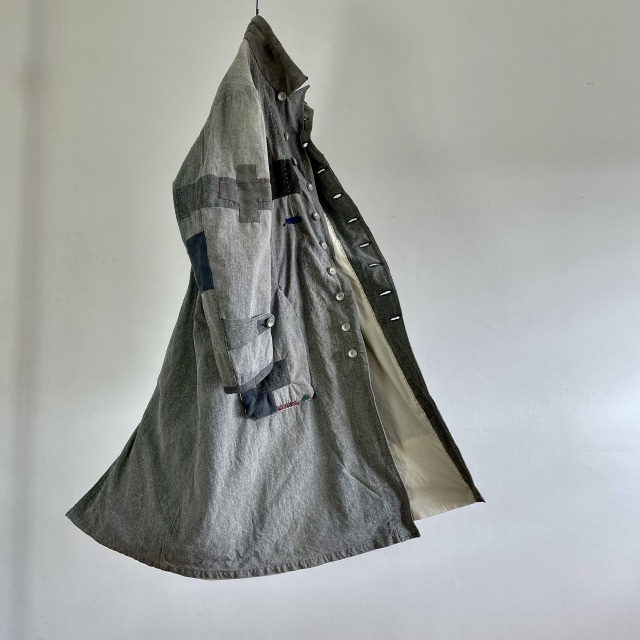
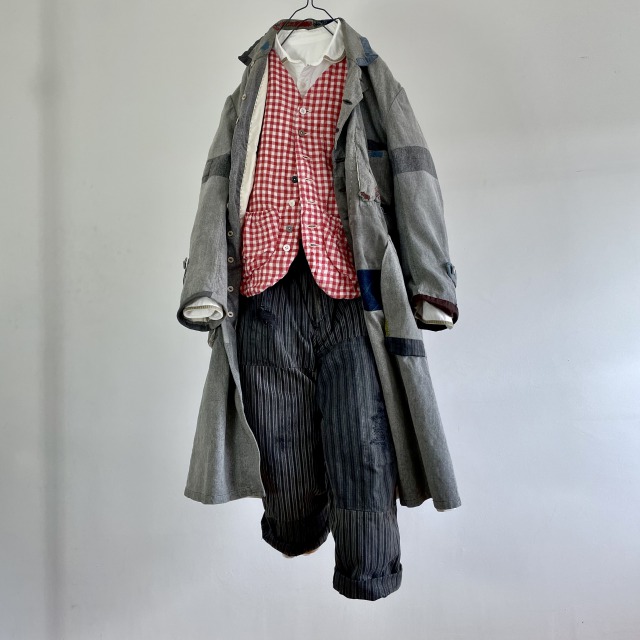
サイズ 2
肩幅 =50cm
バスト=60cm(脇下)
袖丈 =60 cm
着丈 =115cm
フランス/日本製
Front Fabric = French Linen/Cotton Grayish MelangeTwill / Linen/Cotton
Back Fabric = Indian Rustic Cotton Broad Cloth / Cotton 100%
Buttons = Dead Stock French Resin Buttons & Antique Fabric Covered Button
STOREへのリンク
[ALTERATION By Manure Of Drawers] SOLD

